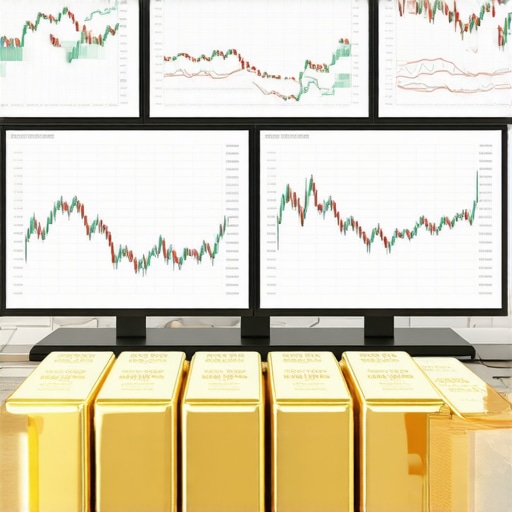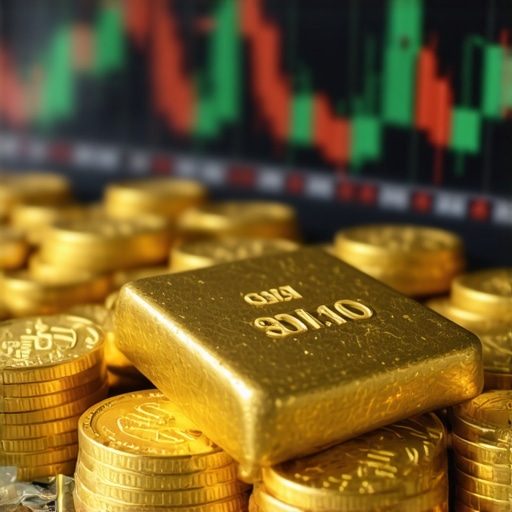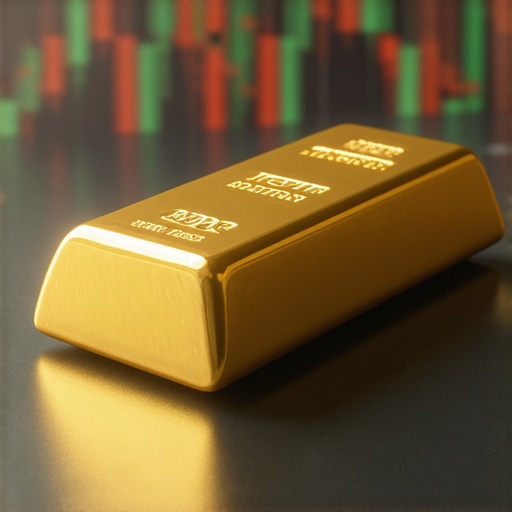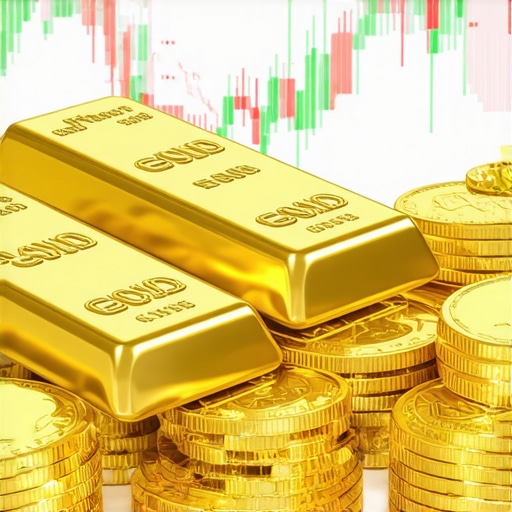Unveiling the Future: What Drives Gold Prices in the Long Run?
Gold has long been revered not just as a precious metal but as a strategic asset that weathers economic storms and geopolitical turbulence. As investors look beyond the immediate horizon, understanding the forces shaping gold price forecasts for 2026 and beyond becomes essential. This journey into the long-term outlook explores the intricate tapestry of supply-demand dynamics, macroeconomic shifts, and technological factors that will define gold’s trajectory in the coming years.
Global Economic Winds: Inflation, Interest Rates, and Currency Fluctuations
One of the most potent influences on gold pricing is the macroeconomic environment. Persistently rising inflation rates, coupled with fluctuating interest rates, traditionally push investors toward gold as a hedge. Central banks’ monetary policies, especially in major economies like the United States and the Eurozone, will continue to sway gold’s appeal. For instance, should inflation outpace interest rate hikes, gold’s allure as a store of value intensifies, potentially driving prices upward in the medium to long term.
Currency volatility, particularly the strength or weakness of the US dollar, also plays a pivotal role. Since gold is priced predominantly in dollars, a weaker dollar often translates into higher gold prices for holders of other currencies, stimulating global demand. This interplay is expected to remain a key factor shaping forecasts through 2026 and beyond.
Mining and Supply Constraints: The Hidden Forces Behind Gold’s Scarcity
Gold supply is inherently limited and subject to complex extraction challenges. As high-grade gold deposits become scarcer, mining operations face rising costs and environmental regulations tightening worldwide. These factors could constrain supply growth, thereby exerting upward pressure on prices. Moreover, geopolitical risks in gold-rich regions may disrupt supply chains intermittently, adding another layer of volatility that savvy investors should monitor closely.
How Will Emerging Technologies and ESG Trends Influence Gold Investment?
Emerging technologies, particularly in mining and recycling, are poised to reshape gold supply dynamics. Advances in extraction methods could improve efficiency, but environmental, social, and governance (ESG) criteria are increasingly influencing mining practices and investor preferences. ESG-conscious funds are driving demand for responsibly sourced gold, which may command premium pricing and alter traditional market patterns.
Additionally, blockchain and digital gold tokens are creating new avenues for gold investment, enhancing liquidity and transparency but also introducing regulatory uncertainties. Understanding these evolving trends is vital for long-term forecasting.
Central Banks and Institutional Demand: The Strategic Accumulation of Gold Reserves
Central banks remain among the largest holders and buyers of gold, using it as a reserve asset to diversify portfolios and hedge against fiat currency risks. In recent years, countries like China, Russia, and India have intensified their gold purchases, a trend expected to persist through 2026. This strategic accumulation underscores gold’s enduring role in global financial stability.
Institutional investors are also increasing allocations to gold-related assets, including ETFs and mining stocks, seeking diversification amid market uncertainties. Such demand patterns contribute to the bullish undercurrents in long-term price forecasts.
Integrating Gold into Your Portfolio: Navigating Uncertainty with Strategic Insight
For investors contemplating gold exposure, understanding these multifaceted trends is crucial. Diversification strategies that include physical gold, ETFs, or mining stocks can help optimize risk-adjusted returns. For a comprehensive approach, consider exploring effective gold investment strategies to maximize returns that align with your financial goals.
Long-term gold price forecasts, while inherently uncertain, benefit from rigorous analysis of fundamental drivers and emerging market trends. Keeping abreast of authoritative insights, such as reports from the World Gold Council, can provide valuable guidance. For instance, their latest research highlights how evolving global demand and supply factors are shaping future gold market dynamics (World Gold Council Gold Demand Trends).
Engage with this evolving conversation—share your perspectives in the comments below or explore more on gold price forecast 2026 and key investment trends to stay ahead in your investment journey.
Technological Innovations and ESG: Shaping the Future of Gold Supply and Demand
The integration of cutting-edge technology and environmental, social, and governance (ESG) principles is redefining gold investment paradigms. While traditional mining faces escalating challenges, innovations such as bioleaching and advanced robotics are enhancing extraction efficiency and environmental sustainability. These technologies promise to mitigate supply constraints but require substantial capital investment and regulatory alignment.
Simultaneously, ESG considerations are prompting investors and producers to prioritize ethical sourcing and minimize ecological footprints. This shift is reflected in the rising popularity of certified conflict-free gold and the emergence of sustainable mining funds. Consequently, demand for responsibly sourced gold is expected to grow, potentially commanding price premiums and altering conventional market dynamics. Investors should stay informed about these trends to align their portfolios with evolving standards.
The Role of Central Banks and Sovereign Wealth Funds in Gold Accumulation
Central banks and sovereign wealth funds are increasingly pivotal in shaping gold markets. Their strategic purchases serve dual purposes: hedging against currency depreciation and reinforcing financial sovereignty amid geopolitical uncertainties. Nations like China and Russia have notably accelerated gold reserve accumulation, signaling confidence in gold’s role as a stable asset.
This accumulation affects supply-demand equilibrium and may induce price support during periods of market volatility. Furthermore, these institutional actors’ behavior often presages broader investment trends, offering valuable signals for market participants. Understanding these dynamics is critical for anticipating long-term price movements and adjusting investment strategies accordingly.
How Can Investors Leverage Gold’s Multifaceted Market Drivers for Portfolio Resilience?
To harness gold’s full potential, investors must adopt a nuanced approach that considers diverse market drivers. Diversifying across physical gold, ETFs, mining stocks, and emerging digital gold assets can optimize exposure while mitigating risks. For example, incorporating top gold ETFs offers liquidity and ease of access, whereas physical holdings provide tangible security against systemic shocks.
Moreover, timing investments with macroeconomic indicators, such as interest rate trends and inflation expectations, can enhance returns. Staying abreast of geopolitical developments and central bank policies further refines decision-making. Engaging with authoritative resources like the World Gold Council ensures data-driven insights. Investors interested in deepening their strategic understanding may find value in exploring effective gold investment strategies tailored for diverse market conditions.
We invite you to share your experiences and perspectives on integrating gold into your investment portfolio in the comments below. For those seeking to expand their knowledge, consider reading more on gold price forecasts and market trends for 2026, enabling informed and proactive investment decisions.
Decoding Complex Market Interactions: The Intersection of Geopolitics and Gold Price Dynamics
The gold market does not operate in isolation; it intertwines deeply with geopolitical developments that introduce layers of complexity to price forecasting. From trade wars and sanctions to regional conflicts and diplomatic realignments, these events create ripple effects that often trigger risk-off sentiment among investors, heightening gold’s safe-haven appeal.
For example, escalating tensions in resource-rich regions can suddenly constrict supply chains, while shifts in alliances influence currency stability. Such geopolitical shocks may not only cause short-term price spikes but also recalibrate long-term expectations about gold’s role as a hedge against systemic risks. Investors equipped with a granular understanding of these interactions can better anticipate volatility and position their portfolios accordingly.
Quantitative Models and Machine Learning: Revolutionizing Gold Price Forecasting Accuracy
In recent years, the integration of advanced quantitative models and machine learning algorithms has significantly enhanced the precision of gold price forecasts. These tools analyze vast datasets encompassing macroeconomic indicators, sentiment analysis, and even satellite imagery of mining activity to identify hidden patterns and predictive signals.
Unlike traditional linear models, machine learning approaches adapt dynamically to evolving market conditions, capturing nonlinear relationships and complex dependencies. For instance, neural networks can parse sentiment from financial news to anticipate investor behavior shifts that precede price movements. However, these models require continuous refinement and domain expertise to avoid overfitting and ensure interpretability.
Investors and analysts leveraging these cutting-edge methodologies gain a competitive edge in navigating gold’s multifaceted market drivers, enabling more timely and informed decision-making.
What Are the Risks and Limitations of Relying on Machine Learning for Gold Price Predictions?
While machine learning enhances forecasting capabilities, several pitfalls warrant caution. Models are only as reliable as the data inputs; inaccuracies or biases in historical data can propagate flawed predictions. Additionally, sudden black swan events—such as unprecedented geopolitical upheavals or regulatory changes—may fall outside the model’s training scope, reducing predictive reliability.
Moreover, the “black box” nature of some algorithms challenges transparency, potentially hindering thorough risk assessment. Therefore, combining machine learning insights with traditional fundamental analysis and expert judgment remains essential to mitigate these limitations and construct robust investment strategies.
Innovations in Gold-Backed Digital Assets: Implications for Market Accessibility and Liquidity
The emergence of gold-backed digital assets, including tokenized gold on blockchain platforms, represents a paradigm shift in market accessibility and liquidity. These instruments democratize gold investment, allowing fractional ownership and instant settlement with lower transaction costs.
However, regulatory frameworks for these digital assets are still evolving, creating uncertainty around custody, authenticity, and fraud prevention. Investors should scrutinize the provenance and auditability of tokenized gold offerings and stay informed about jurisdiction-specific regulations.
Nonetheless, the fusion of traditional gold investment with blockchain technology promises to unlock new liquidity pools and enhance price discovery mechanisms, potentially influencing long-term price trends.
Engage Deeper: Harness Expert Analysis and Evolving Trends for Strategic Gold Investments
As gold markets grow increasingly complex, staying informed through authoritative sources and embracing innovative analytical tools is paramount. We encourage investors to explore detailed research reports from institutions like the Global Finance Gold Price Data and to continuously refine strategies in response to emerging market dynamics.
For those ready to elevate their understanding and investment approach, consider diving into specialized content on gold price forecasts and strategic trends for 2026. Share your insights and experiences with gold investments in the comments below to join a community committed to mastering this multifaceted market.
Decoding Market Sentiment: The Subtle Art of Behavioral Finance in Gold Trading
Beyond tangible fundamentals, investor psychology shapes gold price movements in profound ways. Behavioral finance insights reveal how cognitive biases like herd behavior, loss aversion, and overreaction to news events can amplify volatility in gold markets. Experienced investors integrate sentiment analysis derived from social media, news feeds, and market chatter to anticipate short-term price inflections that traditional models might overlook.
Harnessing these nuanced indicators requires sophisticated tools capable of parsing natural language and gauging emotional intensity. Incorporating such behavioral metrics alongside macroeconomic data enhances the robustness of gold price forecasts and portfolio timing strategies.
Regulatory Landscape Shifts: Navigating Compliance and Market Impact
Emerging regulatory frameworks around gold trading and digital assets are poised to redefine market accessibility and transparency. Stricter anti-money laundering (AML) policies, know-your-customer (KYC) mandates, and cross-border trade restrictions can influence liquidity and investor participation. Compliance complexities vary significantly across jurisdictions, making it imperative for global investors to maintain vigilance on evolving legal standards.
These regulatory shifts may also catalyze innovation in custody solutions, audit protocols, and provenance verification, thereby affecting demand patterns for physical versus tokenized gold.
How Do Macroeconomic Uncertainties Interact with Technological Advances to Shape Gold’s Future?
Macroeconomic uncertainties—such as unpredictable inflation trajectories, divergent central bank policies, and geopolitical tensions—intersect dynamically with technological advances in mining and digital asset platforms. For instance, innovation-driven supply improvements may counterbalance inflationary pressures that traditionally buoy gold prices. Conversely, enhanced market liquidity via tokenization could amplify investor responsiveness to economic signals, accelerating price adjustments.
Understanding these complex interrelations demands interdisciplinary expertise combining economics, technology, and geopolitical analysis, underscoring the need for continuous learning and adaptive investment frameworks.
Authoritative Insight: Incorporating World Gold Council’s Cutting-Edge Research
According to the World Gold Council’s Gold Demand Trends report, evolving consumer preferences and investment behaviors are reshaping demand composition, with notable growth in digital gold and ESG-compliant sourcing. Their data-driven analyses offer invaluable benchmarks for calibrating forecasts and aligning investment strategies with global market realities.
Engage with Expert Perspectives to Elevate Your Gold Investment Strategy
As the gold market’s complexity escalates through intertwining economic, technological, and geopolitical factors, deep engagement with expert analysis becomes paramount. We invite you to explore advanced resources and share your experiences in leveraging these multifaceted drivers to optimize your portfolio resilience. Enhance your strategic acumen by joining the conversation on gold price forecasts and investment trends for 2026.
Frequently Asked Questions (FAQ)
What are the main macroeconomic factors influencing gold prices in 2026?
Key macroeconomic factors include inflation rates, central bank interest rate policies, and currency fluctuations, particularly the strength of the US dollar. Rising inflation with relatively low real interest rates tends to increase gold’s appeal as a store of value, while a weaker US dollar typically supports higher gold prices globally.
How do geopolitical tensions affect gold price movements?
Geopolitical uncertainties such as trade conflicts, regional wars, and sanctions increase market risk aversion. This often drives investors toward gold as a safe-haven asset, causing short-term price spikes and sometimes influencing long-term demand patterns as countries and institutions seek to hedge systemic risks.
What role do central banks and sovereign wealth funds play in the gold market?
Central banks and sovereign wealth funds are significant gold buyers, using gold reserves to diversify foreign currency holdings and hedge against currency depreciation. Their strategic accumulation can provide price support and signal broader market trends, impacting gold’s supply-demand balance and price trajectory.
How are technological innovations changing gold supply and investment?
Advances in mining technology, like bioleaching and robotics, improve extraction efficiency and environmental sustainability. Additionally, the rise of blockchain-based tokenized gold assets increases market accessibility and liquidity, enabling fractional ownership and faster transactions while presenting new regulatory challenges.
What is the impact of ESG considerations on gold mining and investment?
Environmental, Social, and Governance (ESG) criteria are increasingly shaping mining practices and investor preferences. Demand for responsibly sourced, conflict-free gold is growing, often commanding price premiums and encouraging sustainable mining operations, thereby influencing both supply constraints and market demand.
Can machine learning improve gold price forecasting accuracy?
Yes, machine learning models analyze complex datasets and capture nonlinear relationships to enhance forecasting precision. However, they require high-quality data and expert oversight to avoid pitfalls such as overfitting and lack of transparency. Combining these models with fundamental analysis is recommended for robust predictions.
What are the risks of relying solely on quantitative or machine learning models for gold price predictions?
Models may be vulnerable to biased or incomplete data and often cannot anticipate unprecedented events like geopolitical crises. Their ‘black box’ nature can limit interpretability, so relying exclusively on them without human expertise and traditional analysis may lead to flawed investment decisions.
How do digital gold-backed assets affect the traditional gold market?
Tokenized gold assets democratize access to gold investments by allowing fractional ownership and increasing liquidity. While they offer convenience and transparency, regulatory uncertainties and custody risks remain concerns. These digital innovations may gradually influence traditional market dynamics and price discovery.
What strategies should investors consider to integrate gold effectively into their portfolios?
Investors should diversify across physical gold, ETFs, mining stocks, and digital gold assets to balance liquidity, security, and growth potential. Timing investments based on macroeconomic indicators, geopolitical developments, and central bank policies enhances risk-adjusted returns. Continuous learning and engagement with expert research are also crucial.
How might evolving regulations impact gold trading and investment?
Stricter AML/KYC policies and cross-border trade restrictions can affect liquidity and participation in gold markets. Regulatory advancements also prompt innovation in custody, provenance verification, and audit standards, influencing demand for physical versus digital gold products. Staying updated on jurisdictional changes is vital for compliance and strategic planning.
Trusted External Sources
- World Gold Council – As a leading authority on gold market research, their reports on demand trends, investment behavior, and ESG impacts provide comprehensive data and analysis critical for understanding gold’s evolving landscape.
- International Monetary Fund (IMF) – Offers insights into global economic conditions, central bank gold reserves, and macroeconomic factors that influence gold prices and investor sentiment worldwide.
- US Geological Survey (USGS) – Provides authoritative data on gold mining production, reserves, and technological innovations, aiding in assessing supply-side constraints and advancements.
- Bloomberg Commodity Research – Delivers up-to-date market analytics and quantitative modeling insights that help interpret short- and long-term gold price fluctuations.
- Financial Times / The Economist – These respected publications offer high-level analysis on geopolitical events, regulatory developments, and market sentiment shaping gold investment climates.
Conclusion
Understanding gold price forecasts for 2026 requires a multifaceted approach that integrates macroeconomic indicators, geopolitical dynamics, technological innovations, and evolving ESG standards. Central banks’ strategic gold accumulation and the rise of digital gold assets further complicate traditional supply-demand equations. Leveraging advanced quantitative tools alongside expert fundamental analysis empowers investors to navigate this complex market effectively.
Gold remains a resilient, strategic asset amid economic uncertainty, offering portfolio diversification and a hedge against currency and inflation risks. Staying informed through trusted sources and adapting to emerging trends will be essential for maximizing investment outcomes.
We encourage you to apply these insights to your investment strategies, share your perspectives in the comments, and explore more expert content on gold price forecasts and market trends for 2026 to stay ahead in this dynamic market.











This comprehensive overview of long-term gold price drivers really highlights how multifaceted investing in gold has become. I agree that macroeconomic factors like inflation and currency fluctuations will remain key influences, especially as central banks pivot in their policies. What’s particularly intriguing is how technological innovations and ESG trends are beginning to reshape supply and demand — I’ve been following bioleaching and blockchain-based gold tokens, and it’s clear these could significantly alter market dynamics. I wonder, given the rise of digital gold assets, how do you see regulatory developments impacting investor confidence? In my experience, staying updated on both policy shifts and technological advancements is crucial for making informed decisions. Have others had success integrating emerging digital assets into their portfolios while managing regulatory risks effectively? It’s a fascinating time to watch how these trends play out long-term, especially with geopolitical tensions adding layers of complexity.
This post offers a comprehensive view of the multiple factors influencing gold prices in the long run, which I find particularly insightful. I’ve noticed that even with technological innovations like blockchain and digital tokens, traditional fundamentals such as supply constraints and macroeconomic shifts continue to dominate projections. My own experience with institutional holdings shows that central bank purchases often serve as a powerful signal for future price stability or growth, especially when countries like Russia and China ramp up their reserves. One aspect I find increasingly relevant is the impact of ESG-compliant sourcing on premiums for responsibly mined gold, which may become a standard rather than a niche. What’s your take on how these ESG-driven demand patterns might influence long-term pricing and supply resilience, especially as regulatory standards tighten globally? It seems that adapting to these evolving frameworks will be crucial for investors seeking resilience against geopolitical turbulence.